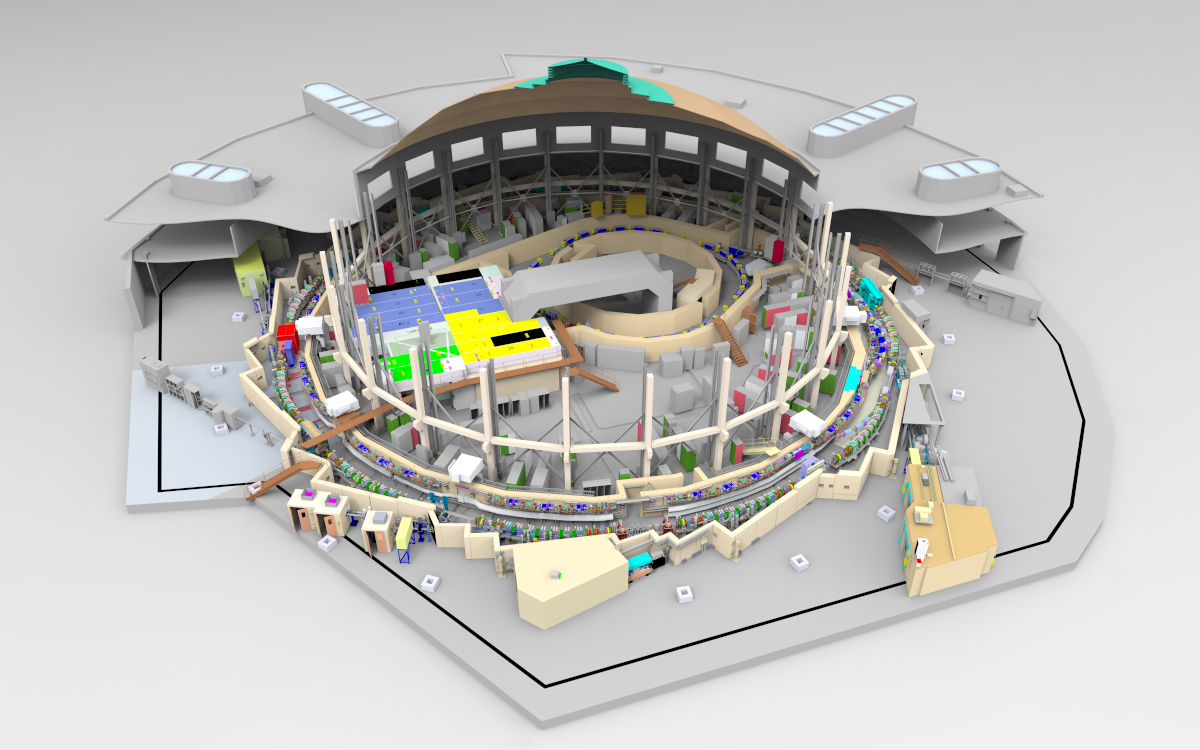VIDEO: The new swap-out injection system will be implemented as part of the $590 million Advanced Light Source Upgrade (ALS-U) project. This unique feature, developed by Berkeley Lab scientists, is a critical component of the upgrade that will enable the ALS to produce brighter beams with a more ordered structure, better revealing nanoscale details in complex chemical reactions and in new materials.
The Advanced Light Source (ALS), a scientific user facility at the Department of Energy’s (DOE) Lawrence Berkeley National Laboratory (Berkeley Lab), has received federal approval for the budget, schedule, and technical scope for a major upgrade project that will boost the brightness of its X-ray beams at least a hundredfold.
In addition to brighter X-ray beams, the ALS Upgrade (ALS-U) project will enable the ALS to deliver light with a more ordered “coherent” structure – like evenly spaced ripples in a pond – that will better reveal nanoscale (billionths of a meter) details in complex chemical reactions and in new materials.
“For nearly three decades, the ALS has developed innovative X-ray tools and used these to support a world-renowned portfolio of user science and collaboration,” said ALS Director Steve Kevan. “The ALS upgrade will allow us to vastly sharpen our tools and to accelerate that work for several more decades as we learn to design chemical, material, and biological systems that will solve the pressing energy and environmental challenges we face.”
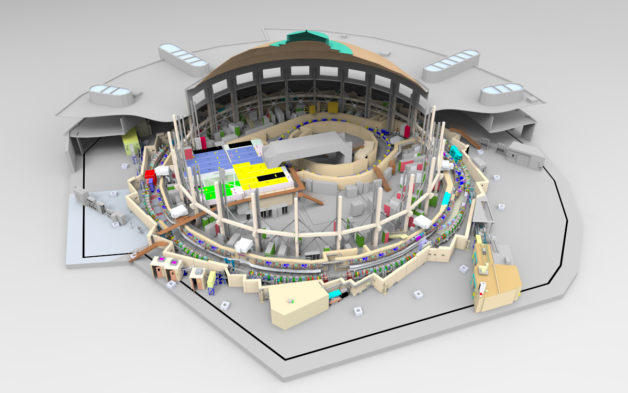
This cutaway rendering of the Advanced Light Source dome shows the layout of three electron-accelerating rings with beamlines. (Credit: Berkeley Lab)
This latest approval by DOE, known as Critical Decision 2 or CD-2, marks the completion of the preliminary design stage of the project. It also authorizes a $590 million budget and funding profile for the project, and outlines the scope and schedule.
“I am proud of the talented engineers, scientists, technicians, and support staff who helped the Lab achieve CD-2 approval for the Advanced Light Source Upgrade project during these challenging times. This upgrade will make it possible for Berkeley Lab to continue its leadership in soft X-ray research for another 30 years – but none of that could happen without the ALS-U team’s hard work and continued commitment to the Lab mission,” said Berkeley Lab Director Mike Witherell.
Probing new materials at the nanoscale with brighter, more focused light
The ALS is a type of particle accelerator known as a synchrotron that generates extremely bright beams of light ranging from infrared through X-rays. There are only a few dozen synchrotron light sources worldwide.
The ALS’ light is directed through 40 highly specialized instruments called beamlines to experimental endstations, where scientists from around the world conduct simultaneous studies in fields ranging from materials science and biology to physics and chemistry. The facility is optimized for science conducted with lower-energy “soft” X-rays that have the ideal energy range to probe the chemical, electronic, and magnetic properties of materials.
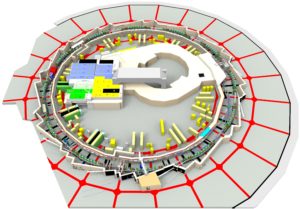
A top view of the ALS storage ring, showing the new equipment that will be installed during the upgrade. (Credit: Berkeley Lab)
For many experiments, the quality of the data collected depends on the number and regularity of light particles – known as photons – that can be concentrated in a small spot. The upgrade currently underway is intended to make the ALS the brightest storage ring-based source of soft X-rays in the world.
The ALS-U project will replace the electron storage ring, the part of the accelerator where light is produced. The ALS’ X-rays are produced by electrons that race around a ring 200 meters (600 feet) in circumference at nearly the speed of light. Along the way, powerful magnets steer and focus the electron beam to keep it on its circular orbit, while additional magnets bend the beam, generating a broad spectrum of light that’s guided through beamlines. Better focus of the electron beam translates to better focus of the light produced and higher-quality data about the samples being studied.
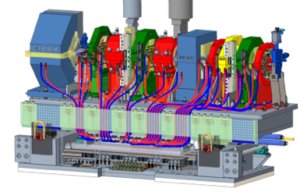
CAD model of a storage ring integrated raft assembly (there are 48 rafts total for the storage ring). This design allows integrated assembly and testing of magnets, vacuum, supports and utilities prior to final installation in the ALS tunnel. (Credit: Berkeley Lab)
The new electron storage ring will leverage a next-generation magnet technology known as multibend achromats. Whereas today each one of the 12 arcs that make up the accelerator ring includes three bending magnets, after the upgrade each arc will include nine bending magnets, allowing for more precise steering and tighter focusing of the electrons.
As a result, X-ray beams that today are about 100 microns (thousandths of a millimeter) across – smaller than the diameter of a human hair – will be squeezed down to just a few microns after the upgrade.
These more precise beams will make possible many applications including the study of magnetic properties in multilayer data-storage materials at smaller scales and the observation of battery chemistry and other reactions as they occur. The increase in brightness will be akin to the crisp, clear resolution that comes from taking a photograph in vivid daylight versus the fuzzy image that results when the lighting is dim.
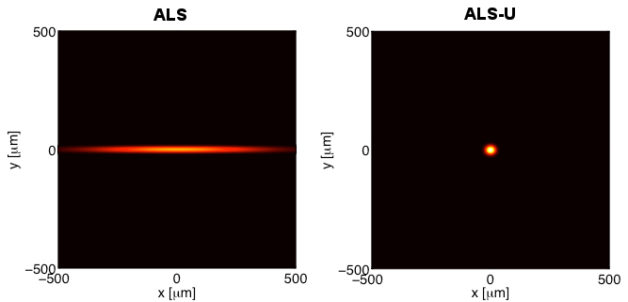
The beam profile of Berkeley Lab’s Advanced Light Source today (left), compared to the highly focused beam (right) that is possible with an upgrade known as ALS-U. (Credit: Berkeley Lab)
A particularly challenging feat of the upgrade will be building a second concentric ring, called an “accumulator,” inside the already-cramped concrete tunnels that house the storage ring. This unique feature, developed by Berkeley Lab scientists, is another critical aspect for better focusing the electron beam. It enables a technique called “on-axis, swap-out injection,” which allows the electron beam to be injected into the storage ring with minimal perturbation.
Whereas in today’s ALS the electron beam is injected from an initial accelerating ring called the “booster” directly into the storage ring, the upgraded ALS will use the accumulator ring as an intermediary between the booster and storage rings, squeezing the electron beam and preparing it to be injected into an extremely confined space while preserving its tight focus and coherence. In late 2019, the project received approval for the early procurement, construction, and installation of the accumulator ring so this critical piece of the project could be installed and commissioned before the facility is shut down for a year to replace the storage ring.
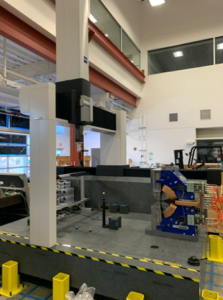
The new coordinate measuring machine in the ALS-U project’s Magnet Measurement Facility. The device will take precise measurements of the new accumulator magnets and prototype storage ring magnets prior to mounting and aligning them in preparation to be installed. The blue magnet shown is a prototype magnet for the storage ring. (Credit: Steve Virostek/Berkeley Lab)
In addition to the replacement of the storage ring and construction of the accumulator ring, the ALS-U project will upgrade two existing beamlines and build two new beamlines with features optimized to take full advantage of the upgraded beam. The project will also provide for the realignment of existing beamlines and a seismic and shielding upgrade of the storage ring tunnel – all while leveraging approximately half a billion dollars in existing infrastructure.
ALS-U is the biggest construction project Berkeley Lab has undertaken in more than 30 years – the last being the construction of the ALS itself under the leadership of former Berkeley Lab Directors David Shirley and Charles Shank. Shirley served as Berkeley Lab Director from 1980 through 1989; Shank, from 1989 through 2004
“This is a big deal,” said ALS-U Project Director David Robin. “Having federal CD-2 approval during uncertain times is a major step.”
Progress under ‘new normal’
Last year, Berkeley Lab, like much of the world, was thrown into uncertainty when word of a deadly new coronavirus was gaining ground. When California Bay Area counties issued a stay-at-home order to slow the spread of COVID-19 on March 17, 2020, Berkeley Lab quickly transitioned to minimal staffing for essential services and curtailed operations at its scientific user facilities – including the Advanced Light Source.
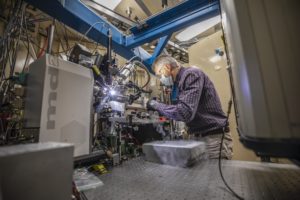
Marc Allaire, pictured in June 2020, setting up one of the Advanced Light Source’s crystallography beamlines for a COVID-19 research project. When California Bay Area counties issued a stay-at-home order to slow the spread of COVID-19 on March 17, 2020, Berkeley Lab quickly transitioned to minimal staffing for essential services and curtailed operations at its scientific user facilities – including the Advanced Light Source. (Credit: Marilyn Sargent/Berkeley Lab)
Under this “new normal,” Robin said that he and Project Manager Roberta Leftwich-Vann decided that the No. 1 priority should be doing the best they could under the unusual circumstances of a pandemic to keep the project on track toward CD-2 review and approval – which, like all things in the times of COVID, wasn’t easy. Robin credits the project’s 100-person team of engineers, scientists, technicians, and support staff for the outstanding job they did in accomplishing all of this under very challenging circumstances.
When California’s stay-at-home orders extended into the summer, the ALS-U project team encountered yet another wrench thrown into their plans: The synchrotron’s summer shutdown – a scheduled “dark” period in preparation for the ALS upgrade project – was shortened, pushing some work into the future, creating a domino effect on the project’s schedule.
“As we approached CD-2, one of the tricky things we needed to get right was developing an informed estimate of potential cost-and-schedule risks represented by the COVID-19 pandemic,” Leftwich-Vann said. “This was new territory, of course, but the team came up with a good solution that helped us solidify our CD-2 cost and schedule: an estimate of future COVID risks based on our experience to date and incorporating likely outcomes based on the best available information.”
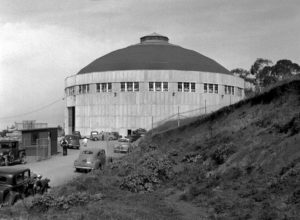
This 1940s photograph shows the original building that housed a 184-inch cyclotron. The building now contains the ALS. (Credit: Berkeley Lab)
Robin said that the ALS-U design is slated for completion in 2022. After that, Berkeley Lab will apply for the next stage of the project: federal “CD-3” approval to start construction on the storage ring replacement, beamline upgrades, realignment, and construction, and begin the seismic and shielding upgrade of the concrete tunnel that houses the storage ring and the accumulator.
The iconic dome of the building that houses the ALS – which was designed in the 1930s by Arthur Brown Jr., the architect for the San Francisco landmark Coit Tower – will be preserved in the upgrade project. The dome originally housed an accelerator known as the 184-inch cyclotron.
“The upgrade will enable the Department of Energy to provide a research tool at Berkeley Lab that is really unique: highly coherent, bright beams of soft X-ray light to probe functional materials for new applications in energy, the environment, and health that isn’t yet possible,” said Robin. “It’s very exciting to think about how this upgrade could help researchers develop new materials and technologies that improve our way of life.”
The Advanced Light Source is a DOE Office of Science User Facility.
Berkeley Lab’s Ashley White contributed to this news release.
More on ALS-U:
- Overview: The Advanced Light Source Upgrade (ALS-U) project
- “Milestone in Advanced Light Source Upgrade Project Will Bring in a New Ring,” news release announcing CD-3A approval, published January 8, 2020
- “Toward a New Light: Advanced Light Source Upgrade Project Moves Forward,” news release announcing CD-1 approval, published September 26, 2018
- VIDEO: Toward a New Light: ALS Upgrade Project Moves Forward
- “Transformational X-Ray Project Takes a Step Forward,” news release announcing CD-0 (mission need) approval, published October 3, 2016
# # #
Founded in 1931 on the belief that the biggest scientific challenges are best addressed by teams, Lawrence Berkeley National Laboratory and its scientists have been recognized with 14 Nobel Prizes. Today, Berkeley Lab researchers develop sustainable energy and environmental solutions, create useful new materials, advance the frontiers of computing, and probe the mysteries of life, matter, and the universe. Scientists from around the world rely on the Lab’s facilities for their own discovery science. Berkeley Lab is a multiprogram national laboratory, managed by the University of California for the U.S. Department of Energy’s Office of Science.
DOE’s Office of Science is the single largest supporter of basic research in the physical sciences in the United States, and is working to address some of the most pressing challenges of our time. For more information, please visit energy.gov/science.
